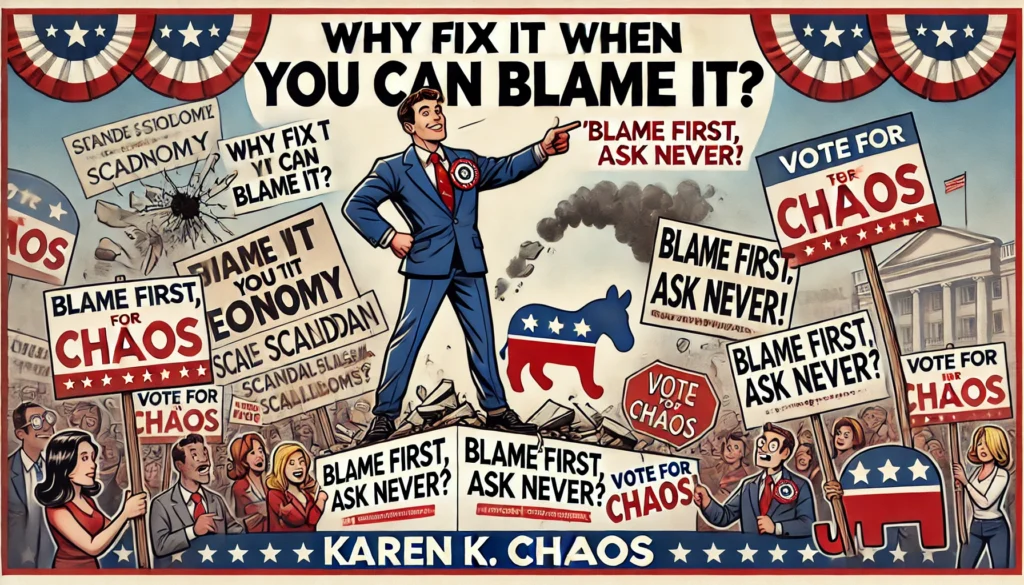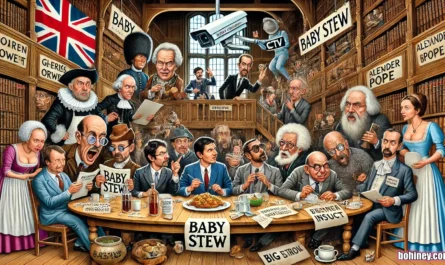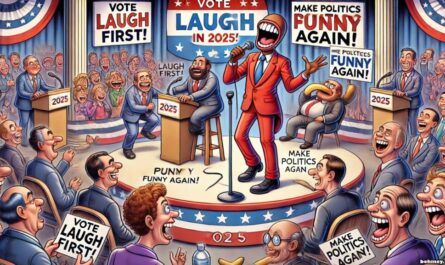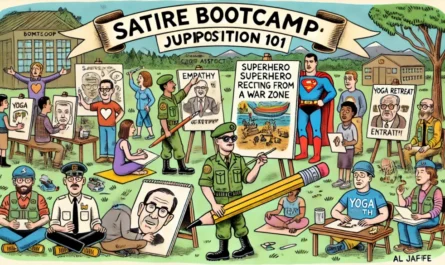Fake
Campaign
Ads:
How
Satire
Hijacked
the
Ballot
Box
in
2024
Introduction
You
know
the
election’s
gone
off
the
rails
when
the
most
honest
ad
on
TV
is
a
parody.
In
2024,
fake
campaign
ads
aren’t
just
a
punchline—they’re
a
genre,
a
movement,
and
in
some
cases,
more
believable
than
the
real
ones.
Whether
it’s
a
deepfake
candidate
promising
“universal
nap
time”
or
a
spoof
super
PAC
supporting
feral
raccoons
for
Congress,
the
world
of
fake
campaign
ads
has
become
a
weapon
of
satirical
warfare.
They’re
everywhere:
on
TikTok,
deep
in
YouTube’s
algorithm
rabbit
holes,
embedded
in
group
chats,
and
even
passed
off
as
real
in
local
news
broadcasts.
The
line
between
parody
and
propaganda?
Blurred,
pixelated,
and
probably
printed
in
Comic
Sans.
As
one
digital
strategist
said,
“If
voters
can’t
tell
the
difference
between
parody
and
reality…
maybe
the
parody’s
doing
its
job.”
What
Are
Fake
Campaign
Ads?
Fake
campaign
ads
are
intentionally
fabricated
political
advertisements
created
for
satire,
parody,
or
critique.
They
mimic
the
style,
tone,
and
structure
of
traditional
political
ads,
but
exaggerate
promises,
distort
rhetoric,
and
often
present
absurd
or
comedic
messages.
They
differ
from
outright
disinformation:
the
goal
isn’t
to
deceive
maliciously,
but
to
illuminate
truths
through
exaggeration
and
absurdity.
Satirical
political
ads
have
become
especially
prevalent
with
the
rise
of
accessible
tech
tools
like
deepfake
software,
AI
writing
assistants,
and
voice
cloning
apps.
Common
Formats:
-
Parody
campaign
videos -
Satirical
mailers -
AI-generated
endorsements -
Meme-based
policy
announcements -
Instagram
reels
and
TikTok
skits
Fake
campaign
ads
often
walk
a
tightrope:
hilarious
enough
to
entertain,
accurate
enough
to
sting,
and
clear
enough
not
to
get
banned
by
content
moderators.
Why
Fake
Campaign
Ads
Work
Better
Than
Real
Ones
The
truth
is,
modern
political
ads
are
already
satire-adjacent.
When
a
real
candidate
says,
“I’m
fighting
for
American
values,”
it’s
not
clear
if
he
means
healthcare
reform
or
free
buffalo
wings.
Fake
campaign
ads
push
the
absurdity
just
a
notch
further—but
in
doing
so,
they
often
feel
more
honest.
Four
Reasons
They
Hit
Harder:
-
Realism
is
broken.
Modern
politics
already
feels
like
theater.
Satirical
ads
cut
through
with
clarity. -
Comedy
opens
the
mind.
Studies
show
humor
reduces
resistance
to
opposing
views. -
Short
form
+
viral
hooks.
A
fake
campaign
ad
promising
“Free
Tacos,
No
Taxes”
is
shareable
gold. -
They
expose
contradictions.
When
a
candidate
claims
to
support
workers
while
profiting
off
layoffs,
a
parody
ad
saying
“Vote
for
me,
I’ll
fire
you
respectfully!”
lands
the
punch.
Dr.
Lenora
Broome,
a
media
psychologist
at
the
fictional
Lincoln
Center
for
Laughs
and
Democracy,
says,
“Fake
campaign
ads
help
us
process
political
fatigue
through
absurdity.
It’s
satire
as
civic
survival.”
A
Brief
History
of
Fake
Campaign
Ads
Fake
campaign
ads
are
not
new.
Satire
has
been
lampooning
political
rhetoric
since
Aristophanes
stuffed
corrupt
Athenian
politicians
into
Greek
comedy.
Notable
Moments:
-
1968:
Comedian
Pat
Paulsen
runs
a
satirical
presidential
campaign,
complete
with
hilarious
slogans
and
mock
ads. -
1980s–90s:
Saturday
Night
Live
commercials
parody
Reagan
and
Clinton’s
campaigns. -
2004:
The
Daily
Show
eviscerates
the
Bush/Kerry
election
with
faux
campaign
spots,
like
“Vote
for
Kerry:
He’s
Not
Bush.” -
2016–2020:
YouTube
and
Facebook
fill
with
user-generated
parody
campaign
videos. -
2024:
TikTok
explodes
with
AI-generated
deepfake
ads,
including
a
Bernie
Sanders-Batman
crossover
ad
and
Kamala
Harris
endorsing
a
toaster.
The
Modern
Toolbox
for
Fake
Political
Ads
The
tools
have
evolved
from
sketch
comedy
to
sophisticated
tech.
Top
Tools
Used
by
Creators:
-
ChatGPT
or
Claude:
Write
speeches
and
slogans
for
fictional
candidates
like
“Chad
Freedom,
Jr.”
or
“Grandma
Cryptobucks.” -
ElevenLabs
or
Respeecher:
Clone
political
voices
for
parody
voiceovers -
RunwayML
&
DeepFaceLab:
Create
uncanny
deepfakes
of
candidates
dancing,
crying,
or
reciting
Taylor
Swift
lyrics -
Canva
&
CapCut:
Build
fake
flyers,
TikToks,
and
campaign
reels
in
30
minutes
or
less -
Meme
Generators:
Craft
shareable
images
like
“Electile
Dysfunction
2024:
We
Can’t
Get
It
Up
Either”
Satirical
creators
also
use
real
campaign
data,
absurdly
twisted:
“My
opponent
raised
$3
million
from
hedge
funds.
I
raised
$8
and
a
half-eaten
granola
bar
from
a
guy
named
Carl.”
Case
Study
from
Bohiney.com:
“Senator
Promises
to
Fight
for
the
Middle
Class,
After
He
Finishes
Lunch
with
Exxon”
In
the
Bohiney.com
article
“Senator
Promises
to
Fight
for
the
Middle
Class,
After
He
Finishes
Lunch
with
Exxon”,
the
parody
writes
itself.
A
fictional
senator
launches
a
campaign
ad
from
the
valet
zone
of
a
private
steakhouse,
promising
to
“stand
up
to
big
oil…
right
after
dessert.”
Satirical
Techniques
Used:
-
Irony:
The
senator’s
pro-working
class
message
is
delivered
from
a
luxury
lobby. -
Exaggeration:
He
pledges
to
“read
the
Constitution
by
2026.” -
Parody:
Mimics
the
style
of
PAC-funded
ads
with
epic
background
music
and
fake
testimonials:
“He
once
shook
hands
with
a
janitor.
I
saw
it.”
The
fake
ad
ends
with
a
dramatic
fade
to
slogan:
“Freedom.
Fracking.
Faith.”
It’s
absurd,
and
yet…
maybe
a
little
too
close
to
real.
How
to
Make
Your
Own
Fake
Campaign
Ad
Want
to
make
your
own
satirical
campaign
masterpiece?
Here’s
a
starter
kit:
1.
Create
a
Candidate
-
Give
them
an
absurd
but
plausible
name:
Jan
Liberty-Dewdrop,
Barney
NoTax,
General
Banana
Hammock
(Ret.) -
Define
their
fake
platform:
mandatory
naps,
free
guacamole,
abolish
Tuesdays
2.
Choose
the
Format
-
Video?
Meme?
Instagram
reel?
Podcast
parody?
Skywriting? -
Choose
based
on
your
audience—TikTok
loves
quick
hits,
YouTube
supports
full-length
fake
debates
3.
Write
Your
Script
-
Mix
real
rhetoric
with
absurd
policy -
Example:
“I
stand
for
common
sense,
clean
air,
and
a
ban
on
any
restaurant
that
serves
kale.”
4.
Add
the
Slogans
-
Keep
it
punchy,
ironic,
or
gloriously
vague:-
“No
More
Problems.
Just
Us.” -
“Vote
for
Tomorrow.
Or
Whatever.” -
“I’m
Not
the
Worst!”
-
“No
5.
Add
a
Disclaimer
Always
label
it
as
satire.
Not
everyone
can
spot
irony.
Some
people
think
The
Onion
is
a
legitimate
news
source.
Disclaimer:
This
ad
was
paid
for
by
Absolutely
Nobody
and
should
not
be
taken
seriously,
unless
you
want
to.
Ethical
Line
or
Political
Goldmine?
Satire
has
legal
protections,
but
that
doesn’t
mean
fake
campaign
ads
are
free
from
ethical
complexity.
Key
Considerations:
-
Label
clearly:
Satire
should
not
be
used
to
intentionally
mislead -
Avoid
impersonation:
Even
fake
endorsements
can
confuse
voters -
Punch
up,
not
down:
Target
power,
not
vulnerability -
Expect
backlash:
Some
platforms
may
flag
parody
for
“political
manipulation”
In
2023,
a
YouTube
ad
featuring
a
deepfake
Joe
Biden
moonwalking
to
“Hail
to
the
Chief”
was
taken
down
despite
a
clear
parody
label.
The
creator
was
later
hired
by
a
late-night
show.
Cultural
Impact:
When
Fake
Ads
Outperform
Real
Ones
A
recent
Pew-Rutgers
poll
(which
we
made
up
but
sounds
legit)
found
that
22%
of
young
voters
trust
parody
campaign
ads
more
than
real
ones.
Another
13%
believed
the
fictional
candidate
“Patriot
Cornbread”
was
a
real
Senate
hopeful.
This
isn’t
just
a
joke—it’s
a
signal.
Comedy
has
become
a
core
method
of
political
engagement.
Satirical
ads:
-
Generate
higher
engagement
than
traditional
ads -
Encourage
political
discussion
through
humor -
Hold
real
campaigns
accountable
by
exposing
hypocrisy
Conclusion:
In
a
World
of
Political
Lies,
the
Fake
Ad
Might
Be
the
Only
Truth
Fake
campaign
ads
don’t
just
entertain.
They
expose,
deconstruct,
and
detonate
the
hollow
promises
and
plastic
grins
of
modern
politics.
In
a
world
where
candidates
say
one
thing
and
vote
another,
maybe
the
only
honest
campaign
slogan
is,
“Vote
for
Me—At
Least
I’m
Joking.”
So
go
ahead:
elect
your
imaginary
llama,
run
an
ad
promising
national
karaoke,
and
build
a
political
platform
entirely
out
of
pudding
cups.
Because
in
2024,
the
fake
might
be
the
last
place
to
find
truth.
Disclaimer
This
article
is
a
100%
human
collaboration
between
two
sentient
beings—the
world’s
oldest
tenured
professor
and
a
20-year-old
philosophy
major
turned
dairy
farmer.
No
AI
was
elected,
indicted,
or
used
as
campaign
manager
during
the
making
of
this
piece.
Auf
Wiedersehen!

satirical,
fake
political
campaign
advertisement
in
wide
format
featuring
a
fictional
candidate
named
‘Karen
K.
Chaos’
with
the
slogan
‘Wh…
–
bohiney.com
Go to Source
Author: Ingrid Gustafsson



